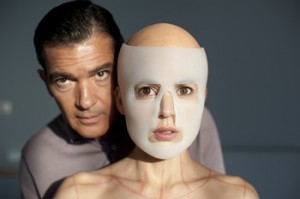Genetics, science, consciousness and will

Skin Deep
![]()
The Skin I Live in – Pedro Almodovar
Must we accept that Genetics defines us? A genotype of an individual is an absolutely unique genetic description of that specific organism: but is it a person? Is my genotype a description of me? If so where shall we find the molecule that is an intention; the gene that is an act of will; still more, when we marvel at the beauty of the DNA double helix, which element within it constitutes the beauty that our response recognises?
I was trained in a philosophical tradition that sees much of metaphysics and more besides, as conceptual mistakes generated by the fact that language permits us to say things which appear to make sense but in fact do not. So for me the above questions are not so much nonsense as non-sense. We do not know what would count as answering them: and even if we did we would not have the language in which to express our conclusions.
The Skin I Live In is about obsession, power, control; but most of all it is about choices: to alter the path of experience by decisions made and acted upon. It is about what is left if all the visible, defining physical features of a person undergo change: the capacity which genetics not only does not, but cannot describe – a willing self; a mind that can deliberate, plan and implement; can change events by choice, by an intentional act. It is about the continuity of identity. It is about consciousness.
The film opens in Toledo in the house of eminent plastic surgeon (a superb Antonio Banderas) Robert Ledgard. He is treating Vera (an elusive, nuanced performance by Elena Anaya), who is beautiful, apparently highly emotionally disturbed and must be locked in and strictly supervised. We conclude she is a patient he is treating for extensive burns. She is encased in a body suit and face-mask to protect what we discover is successful, but unethically experimental artificially generated skin Ledgard has developed.
Ledgard we find has conducted face transplants and his skin research is partly motivated by his late wife’s terrible burns in a car crash. He is acutely aware of the profound impact of his surgical skill on the patients he treats: their sense of identity, self-esteem and self-respect. It is through the skin that we experience and reach the physical world; it is the medium of sexuality and passion.
Through flash-backs we learn that his daughter Norma is emotionally disturbed following her mother’s death and receiving in-patient psychiatric treatment. Against her doctors’ advice, Ledgard removes her from hospital to attend a social gathering. Naively leading on a local lothario Vincente, Norma tries to halt the sex she has initially encouraged: but Vincente does not stop. Panicked, Vincente escapes on his motorbike and is seen by Ledgard who has come looking for Norma and who after the trauma of having been raped returns to care more disturbed than ever. Ledgard seeks out Vincente and exacts a dreadful revenge.
Back to the present with his mother Marilia acting as housekeeper, Ledgard is continuing to treat and try to re-habilitate an increasingly rebellious Vera who we now see bears a strong resemblance to the grown up Norma. Ledgard’s emerging sexual attraction to Vera thus becomes deeply ambiguous: even more eventually than we initially understand. When his feckless brother turns up and tricks his way past Marilia the emotional dynamics take an even darker turn for both Vera and Ledgard.
Ledgard’s world is one of scientific, clinical certainty; of blood, and skin, corpuscle and tissue, steel and glass. Almodovar dispassionately records his precise, meticulous preparations and clinical manner which contrast sharply with his obsessive emotional demeanour and ambiguous sexual responses.
Part mystery, part thriller with the tone of a horror film, Almodovar uses the bizarre, macabre narrative of Thierny Jonquet’s short story Mygale (‘Tarantula’) to lead us to consider issues of gender, personal identity, sexuality and morality in a context which is physically rigorously precise and controlled; but emotionally and conceptually profoundly perplexing.
The conclusion of this challenging but absorbing film is both triumph and tragedy; touching yet bizarre; concluded but not resolved; even though Vincente is in a sense avenged. Fittingly it ends on the image of the DNA Double Helix reminding us perhaps that when science has described everything: it has explained nothing.
Filed under: Director, Pedro Almodovar

